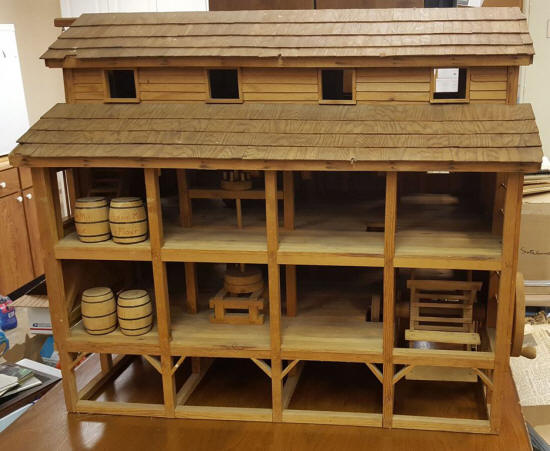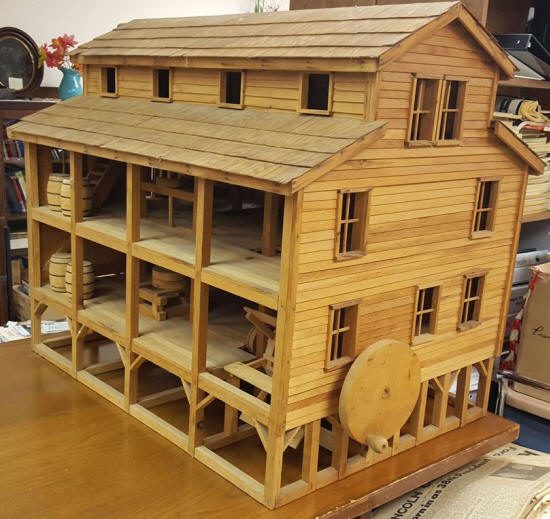|
Logan County Genealogical &
Historical Society explores the history of Rankin Mill and Rock
House at Rocky Ford
Receives gift of Rankin Mill model from
the Wilham Family
 Send a link to a friend
Send a link to a friend
 [October 25, 2021] [October 25, 2021]
At the October meeting of the Logan County Genealogical and
Historical Society member Diane Osborn presented a history of the
Rankin Mill, while Gary Freese presented the history of Rock House
at Rocky Ford.
The Rankin Mill was built in the 1830s and is now gone. However, the
structure lives on through a tabletop model donated to the society
by the Lawrence Wilham family of Mount Pulaski. Lawrence made the
model. On Monday, October 18th, his son Kevin was at the society
meeting to present the model as a gift.



History of Rankin Mill
Construction on Rankin’s Mill was likely begun in the 1830’s, some
20 years before Lincoln was platted.
The Mill was located on Salt Creek at Rocky Ford near the now
vanished paper town of Albany. Both the Mill and Albany were located
on property which was surveyed by chain and tripod and platted by
Abraham Lincoln. And, the Mill was built during Lincoln’s lifetime.
At the time the Mill was built, it was the intent for it to be the
nucleus for the new town. It was the first industry in Logan County.
The Mill’s legal address was the northwest quarter of Section 7,
Township 19, Range 3 west, which would put it in Broadwell Township
about five to seven miles southwest of Lincoln.
When it was beginning to be washed into Salt Creek by the flooding
of 1911, it was considered the oldest Mill in Central Illinois.
The land upon which Rankin’s Mill was built was originally entered
as government land by William Glenn on Aug. 12, 1829.
In 1833, it passed into the hands of Nicholas Sintz. Upon his death,
it went to his heirs.
In 1845, it was purchased by Jonathan Myers, who erected the Mill.
It was built by Alexander Samples and Jesse Spencer.
A few months later, it passed into the hands of Ezra Myers, who
deeded it to Leo W. Myers, the one-time surveyor of Rocky Ford.
Myers sold the Mill to Edmund Rankin in 1851. By 1911 Rankin heirs
owned the property.
The Rankin Mill, which was considered to be strongly constructed,
was never built and finished by any one person.
Peter Sentz laid the foundation, and Ezra Myers and John Champion
placed the burrs, which were known as, “Lost rocks or Niggerheads,”
Rankin later completed the Mill.
Upon acquisition, Rankin made extensive improvements to the Mill.
The stone dam across Rocky Ford was raised and strengthened, sending
a great volume of water against the huge wooded water wheel, which
generated the power for grinding the grist.
The burrs, immense boulders found in the vicinity of the Mill, with
a weight of about 2,100 pounds each, were shaped for crushing grain.
Also introduced was the bolting cloth—known as a great improvement
to the art of milling. The water power also operated a saw mill.
Total cost of these improvements was $20,000.

David Haines was the first miller. The Mill was a busy place in its
heyday, and required three millers when run steady day and night.
Often times twelve and fifteen teams were waiting for their grist.
At an old Settlers Reunion in Lincoln in 1885, Rankin proclaimed his
familiarity with water in general and with Salt Creek, declaring he
had, “Swam every river from Philadelphia to the Mississippi.”
[to top of second column] |
404_small.jpg)
L to R: Diane Osborn, Kevin
Wilham and Gary Freese

In addition to furnishing flour and meal, the Mill was noted for
fish, as many as 800 pounds being caught in one night—the largest
weighing 92 pounds.
The Mill was a popular place for teamsters who would bring their
lunch baskets and stay all night. It was also a popular gathering
spot for farm families.
One account tells of a family invited to a Fish Fry at the Mill with
each family bringing a basket dinner.
For about 30 years the Mill ground to its capacity. As the road and
limestone ford were located on the main traveled way, it became
famed to travelers.
It was reported during the Civil War that some of its clapboards
were loosening and the Mill’s days of usefulness were nearly gone.
According to a newspaper report dated Oct. 2, 1911, “The last
vestige of The Mill is now gone.” The article also noted, “Sentiment
which hovered about its ruins gave inspiration to poets.” And it was
reported by 1911, “The weather beaten clapboard had turned into mere
driftwood.”
Contrary to these statements, a photo in Paul Gleason’s Lincoln: A
Pictorial History, shows a photo of Rankin’s Mill, dated 1929.
Several attendees of the LCGHS program on the Mill informed they had
seen remnants of the Mill during their early years.
The Mill was considered the last noted landmark of the pioneer days.
History of Rock House at Rocky Ford
Another historic site at Rocky Ford was the old Rock House, the only
building of its time located at Albany. It was to have been the
Railroad Station.
The old Rock House was first used as a grocery store and saloon. The
house was built by an old stone mason from Ireland. It was
constructed piece by piece from a neighboring quarry. Abraham
Lincoln used to stay there when he was running for circuit judge.
The first tenant in the stone house was a man by the name of
Bigelow, who dispensed drams of whiskey to the countryside. One of
the first occupants of the home went by the family name of Fulk.
Later, the Rocky Ford ferryman Johnny Myers lived there with his
wife.
Nonnie Loveless, her brother, Wayne Skelton, and their family moved
into the stone house in 1944 or 1945 right after World War II. She
was six or seven years old at the time.

Loveless said she had always been told the house had been used as a
stop on the underground railroad. “It was just an empty house when
we moved in.” There were two rooms on the first floor and two on the
second floor. It had a dirt cellar underneath, where the still had
been located.
“In the basement the dirt was not dug all the way to the wall. There
was a hollow down there, maybe waist high, with board over the top.”
The hollow is believed to have been used as a jail by the saloon
keeper, who had a ladder which could be raised or lowered upon
request.
Loveless said her family used the space to store salted meat and
potatoes, but,“People could have been hidden there.” There was also
an outside cellar. The Rock House had a secret compartment between
the first and second floors where things could be hidden.
Loveless resided in the stone house until she got married in 1954.
Her parents continued to reside there until 1957 or 1958. The house
did not get electricity until 1955. The walls were 13 inches thick,
and Howard, Loveless’ husband, had to build a special drill to bore
into the walls.
After the Skelton Family moved from the house, it was dismantled.
Jean Rankin Anderson, and her father, the late Paul Rankin of
Lincoln, are descendants of Edmund Rankin, who owned the Mill at
Rocky Ford. The family rejects the Underground Railroad connection
to the house, but Paul Rankin has confirmed that Lincoln was
definitely in the vicinity. He stated, “There was a stump in the
field where my great-grandfather and Abe Lincoln would meet and
talk.”
The David Rankin home is the only one of the original Rocky Ford
houses to remain standing.
[Diane Osborn] |